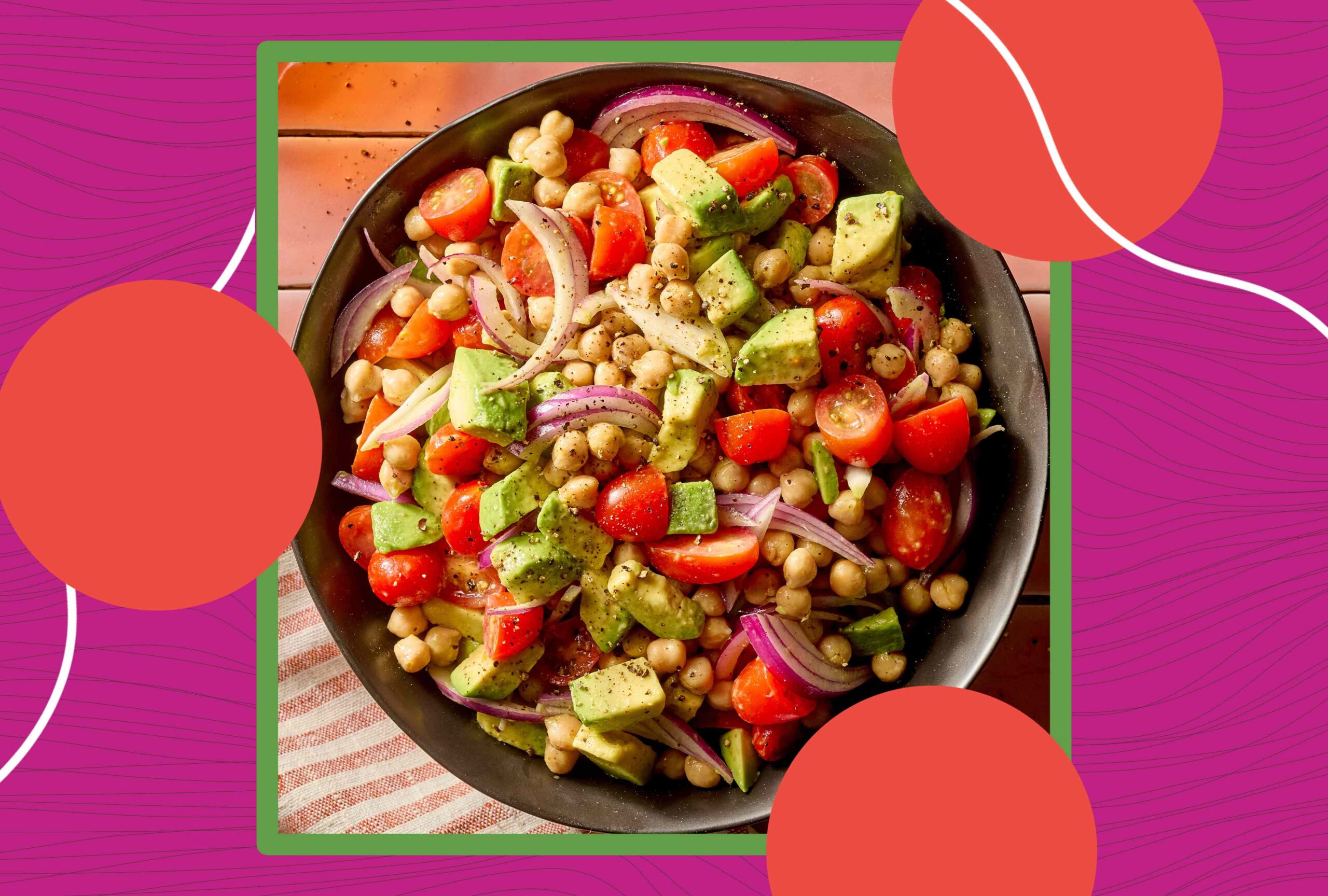:max_bytes(150000):strip_icc():format(jpeg)/The-Best-Lunch-to-Help-Lose-Visceral-Fat-b1ef7b86b71041dba5d804cc9078be07.jpg)
- Visceral fat, or deep belly fat, is linked to a long list of chronic illnesses.
- Foods rich in fiber, antioxidants, healthy fats and protein may help reduce visceral fat.
- This tasty five-ingredient salad contains all of the above and takes just 20 minutes to make.
There’s a stubborn type of belly fat that you can’t burn by doing endless crunches. It’s called visceral fat, and it doesn’t just make your tummy bigger. It’s linked to all sorts of health issues like heart diseasetype 2 diabetes and even depression.
The good news is that certain foods may help reduce this hard-to-lose fat. Sounds good, but when your day gets busy, finding the time to make a healthy lunch can be a challenge! That’s where our five-star 5-Ingredient Avocado & Chickpea Salad comes in. Dietitians say it’s filled with nutrients that can help reduce stubborn visceral fat. Plus, it’s super-easy to prepare and clean up. Read on to learn why you’ll want to make it part of your weekly rotation.
How Our Avocado Chickpea Salad May Help Reduce Visceral Fat
High in Fiber
Canned beans and chickpeas are high-fiber rock stars. Research has found that people who eat more fiber tend to have less visceral fat. This salad’s chickpea base gives you a whopping 17 grams of fiber per serving. That’s more than half of the 28-gram Daily Value and way more than you’d get from lettuce!
All that fiber helps with visceral fat in a couple of different ways. First, when you eat fiber, it travels undigested to your gut, where bacteria that live there ferment it to produce beneficial compounds called short-chain fatty acids. “Research shows these short-chain fatty acids may help reduce fat storage and support a healthier body composition overall,” says Ginger Cochran, M.S., RDN, CDCES. “Fiber [also] helps slow digestion, which helps increase satiety, meaning it helps you feel full for longer. It also slows the absorption of carbohydrates and sugar,” says Avery Zenker, RD, M.A.N. That, in turn, helps balance blood sugar, which can protect against insulin resistancea factor that encourages visceral fat storage.
Rich in Antioxidants
Plant foods like the chickpeas, tomatoes, onions and avocado in this tasty salad are loaded with antioxidants. How do they help reduce belly fat? “Visceral fat promotes chronic inflammation within the body, which can lead to high risk of metabolic issues and more visceral fat accumulation,” says Lindsay Fencl, RD, CD. This can create a vicious cycle that is hard to escape. However, filling your plate with antioxidant-rich plant foods can help break the cycle. Antioxidants help tackle excess inflammation, which may protect against visceral fat accumulation. They’re so effective that research has found that people who follow an antioxidant-rich eating pattern tend to carry less visceral fat.
Supplies Healthy Fats
Fat has many important jobs, such as helping your body absorb fat-soluble vitamins, cushioning your joints and organs and helping you stay warm when it’s cold outside. However, when it comes to visceral fat, saturated fat, found in fatty cuts of red meat and full-fat dairy, may be downright harmful. “Higher intakes of saturated fat are associated with increased visceral fat,” says Zenker. “The majority of fat in this recipe comes from monounsaturated and polyunsaturated fats, primarily from the olive oil and avocado. Replacing saturated fats with unsaturated fats, like olive oil and avocadoscould favor body composition in a way that minimizes visceral fat accumulation.”
Quick and Easy
If you hardly have time for a healthy lunch, you’re going to love this one-step recipe. Made with just five main ingredients, it comes together in 20 minutes flat. The majority of the active time is cutting up the tomatoes, red onion and avocado—easy peasy. Plus, it requires just one bowl, making clean up a breeze. Since it makes four servings, you can crank out several days’ lunches in one quick shot. That could give you more time for a visceral fat–blasting bike ride or power walk!
Other Strategies to Lose Visceral Fat
This quick, easy chickpea and avocado salad is a tasty way to score nutrients to help you lose visceral fat. But don’t stop there. These additional healthy eating and lifestyle tips can help you trim even more visceral fat.
- Prioritize Protein: Research suggests that a higher-protein eating plan that’s slightly lower in calories can kick-start visceral-fat loss (this recipe gives you 14 grams!). Protein works in several ways. First, it’s slowly digested to make meals satiating, and it may help you eat less by regulating hormones that control hunger and appetite. It also requires more energy to digest and absorb than fats or carbohydrates, so it also provides a slight calorie-burning edge.
- Engage in Exercise: What you eat is important, but physical activity is also critical for reducing visceral fat. Any movement helps. But research has found that vigorous aerobic exerciselike jogging, biking or high-intensity interval training (HIIT), is best for targeting visceral fat.
- Get Adequate Sleep: When it comes to losing weight, diet and exercise are usually top of mind. But don’t underestimate the power of a good night’s sleep. Research has found that people who get less than eight hours of sleep nightly often have more visceral fat. One more reason to make getting your nightly eight hours a priority.
Weight Loss Recipes to Try
Our Expert Take
Visceral fat, or deep belly fat, can increase your risk for health issues like heart disease, diabetes and depression, to name a few. The good news is that choosing foods rich in fiber, antioxidants, healthy fats and plant protein may help you trim this hard-to-lose belly fat. Why not start with lunch? Our 5-Ingredient Avocado & Chickpea Salad is loaded with these visceral fat–busting nutrients. Plus, it takes just 20 minutes to prepare, and you probably have most of the ingredients in your kitchen right now. Go ahead and whip up a batch this week. Then use the leftover time for other healthy lunchtime pursuits like an energizing walk or a relaxing yoga break!

